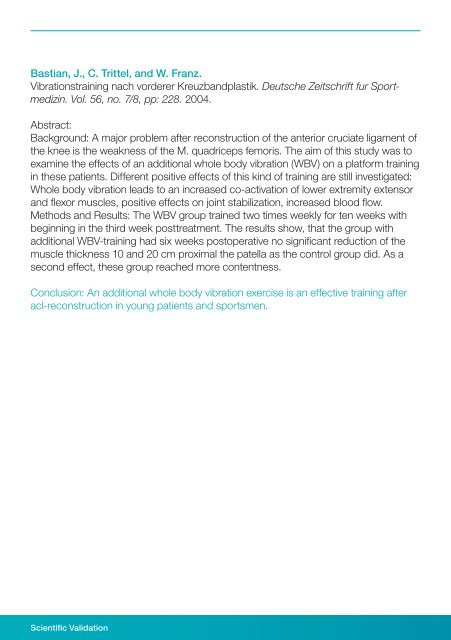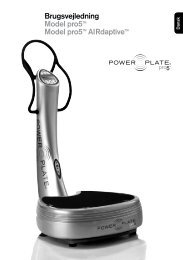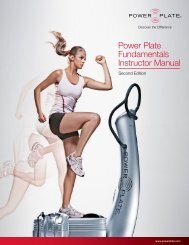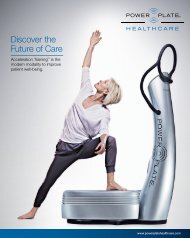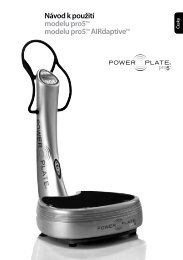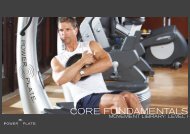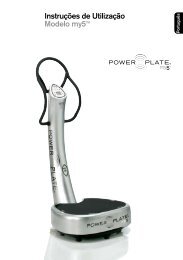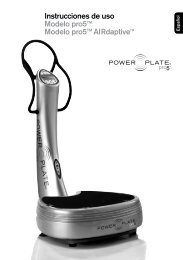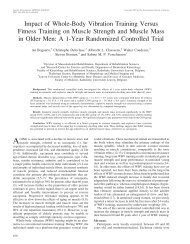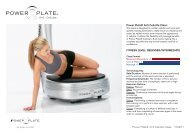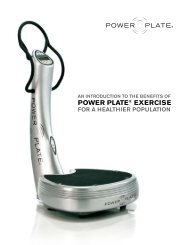Power Plate®
Power Plate®
Power Plate®
Create successful ePaper yourself
Turn your PDF publications into a flip-book with our unique Google optimized e-Paper software.
Bastian, J., C. Trittel, and W. Franz.<br />
Vibrationstraining nach vorderer Kreuzbandplastik. Deutsche Zeitschrift fur Sportmedizin.<br />
Vol. 56, no. 7/8, pp: 228. 2004.<br />
Abstract:<br />
Background: A major problem after reconstruction of the anterior cruciate ligament of<br />
the knee is the weakness of the M. quadriceps femoris. The aim of this study was to<br />
examine the effects of an additional whole body vibration (WBV) on a platform training<br />
in these patients. Different positive effects of this kind of training are still investigated:<br />
Whole body vibration leads to an increased co-activation of lower extremity extensor<br />
and flexor muscles, positive effects on joint stabilization, increased blood flow.<br />
Methods and Results: The WBV group trained two times weekly for ten weeks with<br />
beginning in the third week posttreatment. The results show, that the group with<br />
additional WBV-training had six weeks postoperative no significant reduction of the<br />
muscle thickness 10 and 20 cm proximal the patella as the control group did. As a<br />
second effect, these group reached more contentness.<br />
Conclusion: An additional whole body vibration exercise is an effective training after<br />
acl-reconstruction in young patients and sportsmen.<br />
Bogaerts, A., C. Delecluse, A. Claessens, W. Coudyzer, S. Boonen, and S. Verschueren.<br />
Impact of Whole-Body Vibration Training Versus Fitness Training on Muscle Strength<br />
and Muscle Mass in Older Men: A 1-Year Randomized Controlled Trial. Journal of<br />
Gerontology: Medical Sciences. Vol. 62A, No. 6, pp: 630–635. 2007.<br />
Abstract:<br />
Background. This randomized controlled study investigated the effects of 1-year<br />
whole-body vibration (WBV) training on isometric and explosive muscle strength and<br />
muscle mass in community-dwelling men older than 60 years.<br />
Methods. Muscle characteristics of the WBV group (n¼ 31, 67.3 6 0.7 years) were<br />
compared with those of a fitness (FIT) group (n ¼ 30, 67.4 6 0.8 years) and a control<br />
(CON) group (n ¼ 36, 68.6 6 0.9 years). Isometric strength of the knee extensors was<br />
measured using an isokinetic dynamometer, explosive muscle strength was assessed<br />
using a counter movement jump, and muscle mass of the upper leg was determined<br />
by computed tomography.<br />
Results. Isometric muscle strength, explosive muscle strength, and muscle mass<br />
increased significantly in the WBV group (9.8%, 10.9%, and 3.4%, respectively) and<br />
in the FIT group (13.1%, 9.8%, and 3.8%, respectively) with the training effects not<br />
significantly different between the groups. No significant changes in any parameter<br />
were found in the CON group.<br />
Conclusion. WBV training is as efficient as a fitness program to increase isometric and<br />
explosive knee extension strength and muscle mass of the upper leg in communitydwelling<br />
older men. These findings suggest that WBV training has potential to prevent<br />
or reverse the age-related loss in skeletal muscle mass, referred to as sarcopenia.<br />
Scientific Validation 45


